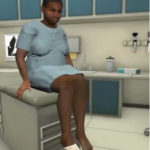Virtual Reality Simulation in Online Healthcare Education
Tina the Avatar takes simulation to a new level.
At Drexel University, the College of Nursing and Health Professions is well acquainted with the educational merit of using patient proxies to teach essential clinical skills in high tech, high touch simulation laboratories on campus. But this arrangement is far from convenient for its many online nursing students so to engage their clinical imaginations and sharpen their clinical assessment skills from a distance, the college is moving its lab onto the laptop with the help of virtual reality and an ingenious avatar called Tina Jones.
Virtual reality is an immersive interactive, three-dimensional, computer-generated environment that enables us to assume virtual identities as we seamlessly move about in cyberspace manipulating objects and performing certain actions. And while we usually associate it with the imaginary worlds of entertaining video games, virtual reality is fast becoming a popular teaching and learning enhancement among educators dedicated to helping their students learn by doing.
A benefit that led that ever more inventive faculty at Drexel’s College of Nursing to utilize Tina the Avatar. Designed by Shadow Health, this 29 -year old virtual patient responds like any real-life patient with a complicated medical history, and a distinct personality. And she offers a unique chance for students to test drive their diagnostic and interpersonal skills by performing high stakes clinical assessments over and over, if necessary. Likewise by observing the interaction online instructors can supply face-to-face feedback around targeted areas for improvement through video conferencing applications like Skype and Zoom.
So how does Drexel’s online nursing students describe the benefits of their virtual patient encounter? One RN to BSN student contends that, “By getting to know Tina as a human being with real needs and emotions, she came to realize that nursing isn’t just about treating and streeting patients but rather it’s about equipping them to live healthier and happier lives.” Yet another student who is a seasoned nurse explains That Tina the Avatar offered her a chance to practice her assessment skills from a much more comprehensive perspective, having never actually performed a full system head-to-toe patient assessment. And although she missed more than a few diagnostic clues doing her first encounters, she became much more proficient with each subsequent session which in turn enhanced both her capacity and her confidence as a nurse. And for the nursing faculty at Drexel, outcomes such as these have led to the innovative use of virtual reality and other programs to help their online students translate classroom knowledge into real-world skills, a real bonus for their patients.
Drexel University’s School of Nursing continues to maximize the latest technologies to enrich their programs. Tina Jones, the avatar, is another fine example of using simulations mixed with virtual reality for experiential learning.
Meet Tina, the 28 year-old woman with whom many CNHP students are now familiar. Although she is a virtual avatar and the product of educational software developer Shadow Health, as far as CNHP students are concerned, Tina is a real patient.
VSIM in Nursing Fundamentals
Drexel University and the College of Nursing and Health Professions have long been at the forefront of innovation and new technology. As a result, some CNHP programs like the Physician Assistant and Pre-licensure Nursing programs are beginning to use a new type of technology in their curricula for both practice and assessment purposes.
Shadow Health’s Tina avatar is a character in their web-based interactive system, similar in some ways to the popular online avatar world Second Life, though geared specifically toward students in clinical health professions fields.
According to Dr. Leland “Rocky” Rockstraw, assistant Dean of Simulation, Clinical & Technology Academic Operations, “You knock, go into the room, interact and ask questions. Based on the questions you ask, she will respond in certain ways.”
Dr. Rockstraw continued, “You also click and touch, where you conduct physical checkups.” What truly makes Shadow Health unique, however, is that Tina acts like a real patient by responding to how she is treated, approached or the type of questions she is asked by the student practitioner.
Shadow Health’s VSIM tool is broken down into 10 modules, each of which correlate with a body system that nursing students learn about in class. The program serves not only as reinforcement for learning in the classroom, but also as a source to develop interpersonal skills needed by clinical professionals. “The response is instant,” said Dr. Rockstraw. “It encourages the students to practice skills based on that immediate feedback given by the software. It almost acts as a source of standardization.”
Benefits of Simulation in Nursing Education
Several academic departments within the College of Nursing and Health Professions have been beta testing this program with current students. The Physician Assistant and Nurse Anesthesia programs are considering using Shadow Health as an online supplement to learning. The RN-BSN Program has already approved Shadow Health as a required supplement to the already rigorous curriculum, starting this winter term. Another benefit of the software is that CNHP faculty can provide direct critical feedback to students based on how they interacted with Tina. Professors are able to view the type of questions asked by the student and how the student reacted in turn to Tina’s responses. They are then able to give the student advice and make recommendations for interpersonal skill improvement.
Though quite similar to the actual real-life standardized patient evaluations, Dr. Rockstraw sees certain advantages to using Shadow Health in addition to the other simulation activities in which CNHP students have been partaking for years. “Real-life standardized patient evaluations only allow one attempt per student, but with Tina, the student is allowed to learn through repetition as many times as they want,” he elaborated. “It is unique because we are in-line with Drexel’s innovative and technology-infused learning mission.”
Supplemental Links
- About Tina the Avatar
- About Drexel University Online
- Design company partner: Shadow Health

